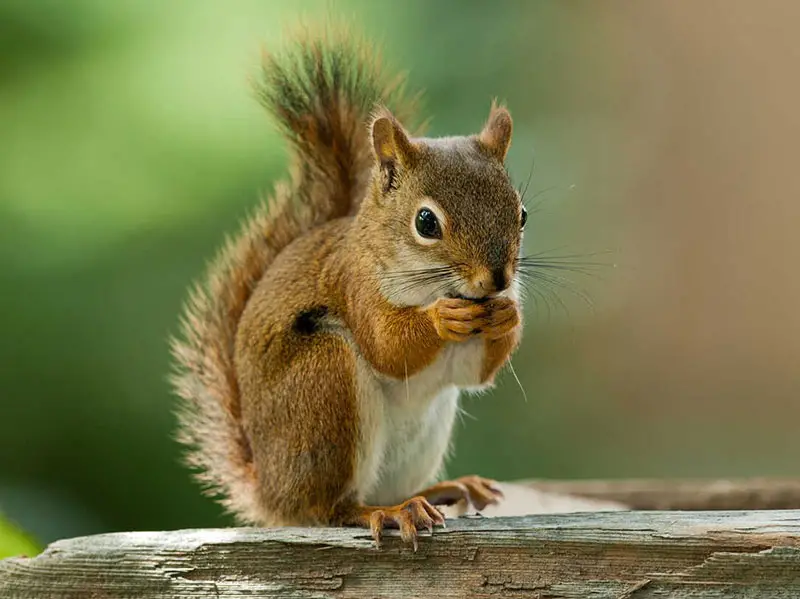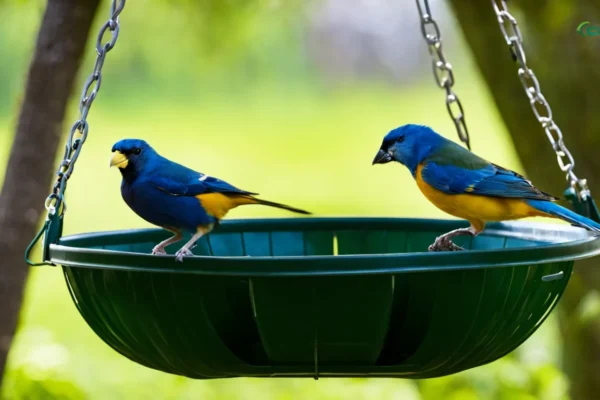You can find squirrels in backyards, parks, wooded areas, and pretty much anyplace there are trees. These fuzzy tiny critters are adept at jumping between branches, flying through the air to scale trees, and sprinting up trees to avoid dangers from the bottom. Many of us like the agility of squirrels and get excited when we see their bushy tails in our backyards. They will happily accept any food that people leave out and may benefit immensely from additional human feeding. For this reason, it’s important to know what meals to provide them in order to maintain their health.
Garden birds are often fed peanuts, which are a rich food source that many of them love and may be quite beneficial to them. Can you give peanuts to squirrels, though? In summary, you may, but squirrels shouldn’t eat them as their primary source of nourishment since they don’t provide much nutritious value. Giving peanuts as a reward should only happen seldom and only in the proper form—raw peanuts are strictly forbidden! Granted, roasted peanuts are preferable, but stay away from salted and too oil-roasted varieties.
We want to clear up any confusion you may have on the appropriate feeding practices for squirrels, including what kind of food to feed them and why. We will ascertain their dietary patterns and the ways in which we may support their nutrition in order to enable them to endure their winter hibernation.
Ecology of Squirrels
We’ll look more closely at the ecology of squirrels in order to better understand their connection with peanuts.
The Sciuridae family, which also contains chipmunks and prairie dogs, is home to squirrels. There are many distinct species of squirrels, such as flying, ground, and tree squirrels, each having unique traits and preferred habitats. A typical trait that easily identifies a squirrel is its bushy tail, which is not only a cute feature but also serves a variety of survival functions, such as:
Weather protection is necessary to keep the rain, wind, and cold off their bodies and preserve body warmth.
Counterbalance: A squirrel’s tail aids in maintaining its balance when it jumps through trees and holds onto branches. Moreover, the tail may function as a parachute, preventing them from falling as they plummet to the earth or land on lower branches.
Temperature control: A squirrel may lower its core body temperature by pumping more blood to its tails when it becomes too hot.
Squirrels communicate with their tails, exactly as a companion dog or cat might. Other squirrels will keep an eye out for tail signals from their fellows, which indicate the presence of danger.
A squirrel can twist its ankles 180 degrees, demonstrating how highly flexible and mobile the rest of their body is! They are mostly visual hunters and foragers because of their large eyes, which suggest superior eyesight. They live in many different places on Earth, from semi-arid desert areas to tropical rainforests.
Nearly every species of squirrel is arboreal, meaning it lives in trees, and is active throughout the day. However, how much time is spent in trees varies greatly by species. For example, Oriental giant squirrels (seen below) are one species that seldom venture below ground. Conversely, other animals—like African palm squirrels—spend the majority of their time feeding at ground level.

Natural Diet And Squirrel Feeding Practices
Squirrels eat mostly plants in most of their environments; they are herbivores. Nonetheless, they may also consume insects, bird eggs, carrion, and even tiny vertebrates such as young birds, making them technically omnivores. They will look for nuts, seeds, fruits, fungus, and other plant components such as buds, leaves, bark, nectar, and flowers in an opportunistic manner.
Like other rodent species like rats and marmots, squirrels have strong jaws and huge incisors. These enable them to efficiently chip through tough nut shells and remove the cambium—the newly formed, live layer of bark—from trees. Gnawing on hard shells and barks helps maintain the health of these distinctive incisors, which develop continuously throughout the life of the squirrel.
Foraging for extra food in the autumn and burying it to uncover in the spring is a frequent practice among squirrels in the Northern Hemisphere. When they emerge from hibernation, hidden nuts may be of considerable advantage to them since, at this time of year, it may be difficult to acquire sources of high-protein and high-fat diet. In addition to feeding to put on weight in order to survive the harsh, frigid winter, they will also prepare for hibernation.
The kind of squirrels you are most likely to see in your backyard and in and around cities are tree squirrels, such as grey or red squirrels depending on whether you reside in the US or certain parts of Europe. Being effective synanthropes, these creatures flourish in human-populated places and gain from human contact. This is often accomplished by either planned feeding, in which food has been set out for them, or opportunistic feeding, in which animals search for food scraps that humans have dropped or steal from bird feeders.
It’s a regular and safe habit to give peanuts to birds, but is it also OK to feed squirrels? If that’s the case, how should you deliver the peanuts? Let’s examine more closely.
Is It Safe To Feed Peanuts To Squirrels?
One should always think about the possible outcomes before giving squirrels food. You may assist in eradicating their fear of people and enhancing their fearlessness by allowing them to feed in the park or your garden. This may put them at greater danger of getting driven over in places with busy roads or make them more vulnerable to cat predation. Furthermore, this might result in their taking bird food and taking over bird feeding locations, which would deter birds.
It’s important to provide squirrels the correct kinds of food if you’ve thought about these things and would still want to give them some food sources. This will help them hibernate through the winter successfully, improve their health, and generally feel better.
Squirrels, like humans, need a variety of foods to be healthy. They need an abundance of protein, carbohydrate, and fat sources since they cannot effectively digest cellulose. They may benefit greatly from a variety of unsweetened and unsalted fruits, vegetables, and nuts and seeds, such as:
Walnuts, almonds, pistachios, and hazelnuts
Sunflower and pumpkin seeds
Apple, grapes, raisins, and watermelon chopped
Cucumber, carrots, cucumber sprouts, spinach, celery, and green beans
Regular cleaning and disinfection of feeding facilities and equipment is necessary to stop the spread of illness. Giving squirrels hand food is also a bad idea since it might make it more difficult for them to locate food on their own in the wild.
Can Squirrels Eat Peanuts?
In theory, squirrels can consume peanuts, but this should only happen sometimes as a reward. Since peanuts are not particularly nutritious for squirrels, they shouldn’t make up the majority of a squirrel’s diet. Giving them peanuts in the appropriate shape is also crucial.
As legumes, peanuts are not really nuts. This indicates that they have unique qualities, such as being abundant in fiber and containing certain necessary minerals and vitamins for protein. Antioxidants and poly- and monounsaturated fatty acids, which offer many health advantages, are also present in them.

Do Squirrels Consume Raw Peanuts?
No! Aflatoxin, a carcinogenic that may harm squirrels’ livers, is present in raw peanuts and should be avoided. This fungus toxin prevents the pancreas from producing trypsin, an important enzyme that is necessary for protein absorption.
Thus, be sure the peanuts you give squirrels are free of aflatoxin.
Can Roasted Peanuts Be Eaten by Squirrels?
Squirrels should avoid dry-roasted peanuts from shops since they are high in salt (more on this below). On the other hand, oil-roasted peanuts may have a high oil content and hence a high calorie content.
Of the two, oil-roasted peanuts are the superior choice because when it comes to feeding squirrels, surplus calories are better than excessive salt levels. But watch out that there’s not too much oil in there! You can roast your own raw, hulled (sans shell) peanuts if you’re very certain. Here are some guidelines on how to do this securely.
Squirrels shouldn’t be given store-bought roasted peanuts since they may also include sugar and flavorings, and too much refined sugar is unhealthy for them.
Could Squirrels Consume Salted Peanuts?
Salty foods should generally not be given to animals, domestic or wild. While their kidneys cannot handle the excess salt in salted peanuts, squirrels can comfortably withstand tiny amounts of salt.
Make sure the nuts or peanuts you give squirrels aren’t salted by carefully inspecting them. To double verify the amount of salt, it is okay to sample a little yourself if you are uncertain.
This is a good point to mention that, while feeding animals, it is highly advised to have a freshwater source nearby so they can drink. This will facilitate their digestion and help them stay hydrated.
For squirrels, should you shell or hull peanuts?
Giving squirrels shelled peanuts may be dangerous even though it might be beneficial for them to eat shelled nuts as it helps to wear down their constantly developing incisors. Unvisible to the naked eye, a poisonous mold sometimes grows within the shells.
For squirrels, roasted peanuts in their shells may be a less dangerous treat. Some squirrels even like to gnaw on the shells in addition to the peanuts (see a video of this here!). You may read more about giving squirrels shelled peanuts here.
It’s possible that your neighborhood squirrels have alternative sources of dental care if they are not only dependent on the food you provide them and are also actively scavenging for food. As a result, hulled (or unshelled) peanuts could be a safer and superior choice.
Where Are Peanuts for Squirrels Sold?
Purchasing peanuts in large quantities may be a cost-effective method of providing squirrels with treats, since they should only be given in tiny quantities and infrequently. It’s simple and affordable to purchase bulk bags of peanuts online; but, be sure to use the tips in this article to confirm that squirrels may safely consume them. Alternatively, you may purchase raw peanuts and gently roast them so that they are safe for squirrel ingestion.
Shelled or hulled raw peanuts are often available from neighborhood backyard feed dealers.
The Practicalities of Feeding Squirrels Peanuts
Spreading out many feeding locations across your lawn is advised when creating squirrel feeding places. As a result, there will be less rivalry and conflict amongst squirrels over food. You may make sure other animals can’t take the food by using a dedicated squirrel feeder, which will only allow squirrels to reach it.
The peanuts may be placed in the open, in a dish, or on an elevated platform if you don’t mind other creatures using the feeding opportunity.
To stop the spread of illness, keep these feeding locations clean. If old peanuts start to mold or get wet, replace them.






